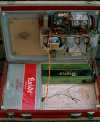 Inside, you can see the two big zinc-carbon batteries that power
the
HT
(90V) and the valve heaters (1.5V).
Pasted to the bottom of the box is a circuit diagram (schematic).
Inside, you can see the two big zinc-carbon batteries that power
the
HT
(90V) and the valve heaters (1.5V).
Pasted to the bottom of the box is a circuit diagram (schematic).
| Ageing Audio |
Here are radios, amplifiers and tape recorders from the age of valves (or even the age of vacuum tubes). Oh, and a few quadrophonic gadgets. While viewing this page, try to imagine the smell of burning dust that you get when an old radio warms up...

An FM radio from 1957, complete with magic eye tuning indicator. Note that the VHF scale goes from 88MHz to 100MHz, whereas modern sets go up to 108MHz. At the time, the broadcast band for FM only went up to 100MHz; stations above that frequency are a recent development.

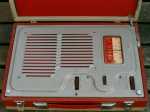
Mid-1950s portable radio, made by the Ever Ready battery company. Medium and Long wave-bands, and a frame aerial in the lid of the box. Opening the box switches on the radio.
 Inside, you can see the two big zinc-carbon batteries that power
the
HT
(90V) and the valve heaters (1.5V).
Pasted to the bottom of the box is a circuit diagram (schematic).
Inside, you can see the two big zinc-carbon batteries that power
the
HT
(90V) and the valve heaters (1.5V).
Pasted to the bottom of the box is a circuit diagram (schematic).
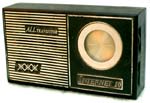
How appropriate, an Internet radio. It's just a fairly ordinary transistor radio of the late 1960s or early 1970s, made by a company called Internet. It uses germanium transistors with Mullard GET113 part numbers. The writing on the front reads "ALL transistor" and "Internet 10". Like the Ever Ready, it has MW and LW bands, selected by a switch on the back.
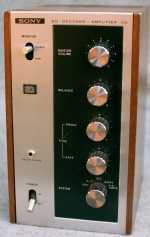

Quadrophonic hi-fi was popular in the 1970s, but died out with the introduction of digital audio on CDs (nowadays, we'd call it 4.0 stereo). This Sony unit is a combined SQ decoder and rear channel amplifier. It took in an SQ-encoded signal from your existing stereo gear, separated out the front and rear channels and then sent the front channels back into the stereo. The rear channels were amplified and fed to the rear speakers. Try to imagine how many wires were needed to hook this thing up!
Sony made a whole range of hi-fi gear in this vertical format during the 1970s. I don't have any other parts of the system, though.
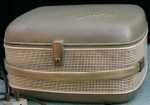
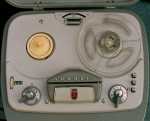
After the Second World War, developments in tape recording technology led to the domestic reel-to-reel machine. This is a Grundig TK24, a quarter-track (also known as four-track) mono tape recorder from the late 1950s. It looks like an electric overnight bag when closed, but it's much heavier than it looks. The circuits are built from valves, and the recording level indicator is a magic eye (similar in principle to a cathode-ray tube).



The doomed Philips Digital Compact Cassette format. My example is a DCC730 deck, which was a full-size HiFi separates model. It boldly describes itself as an 18-bit digital recorder. Also shown are the front and rear of a DCC tape.
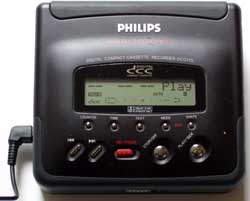
One of the Philips DCC portable models.
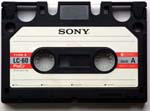
The equally doomed Sony Elcaset format. Mine is a Sony EL-5 deck, the simpler of the Sony models.
There were a few rival quadrophonic audio systems, some based on the idea of squeezing four channels into two, and others simply recording and playing back four parallel channels. CD-4 was an encoding system that squeezed four channels into two by modulating the two rear channels onto an ultrasonic subcarrier. This high-frequency modulated signal was then recorded on vinyl records and played back with a special stylus and pickup cartridge. The stylus went by the name of Shibata, but unfortunately I have neither that nor the special cartridge.
What I do have, though, is the box that demodulates the high-frequency carrier and recreates the two rear channels. I have a record (yes, one record) that has a CD-4 recording on it. It's Playing Possum by Carly Simon, 1975.
 Rather smaller than the CD-4 Demodulator, this is another
decoder (like the Sony) for the SQ quadrophonic system.
Note that Pioneer made decoders for both CD-4 and SQ systems.
Also note that the Sony mentioned above includes rear channel
amplifiers, while the Pioneer models don't.
Rather smaller than the CD-4 Demodulator, this is another
decoder (like the Sony) for the SQ quadrophonic system.
Note that Pioneer made decoders for both CD-4 and SQ systems.
Also note that the Sony mentioned above includes rear channel
amplifiers, while the Pioneer models don't.

A forerunner of the 8-track format, this is a 4-track machine intended for use in a car. It has the usual 12-volt power supply, but is much bigger and heavier than a modern car radio or tape player. Unlike the 8-track, the playback head is fixed and selection of the two stereo programmes on the tape is by an electrical switch. 8-track players physically move the head up and down to select programmes, usually by a solenoid and ratchet mechanism.
Rather a neat little 8-track playback unit. No power amplifiers, not many controls (just the track-change button) and simple styling. Not even lights to show which programme's playing. Just the thing for playing Pink Floyd's Dark Side of the Moon cartridge on.

An altogether fancier 8-track player, with lots of slider controls,
amplifiers to drive four speakers directly, and the ability to play
either stereo or quadrophonic cartridges.
Unlike the SQ or CD-4 systems, the quadrophonic 8-track plays four
quite separate channels in parallel.
Tapes and players that can do this carry a Q-8 label.
An extra notch in the plastic of the cartridge operates a switch
in the player and changes it into four-channel mode.
Golding Audio Ltd.
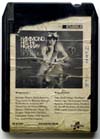 I have three cartridges in this format, one of which is
Hammond Hits the Highway
by Harry Stoneham, on the Studio 2 label.
The Hammond in the title refers to the electronic organ, the only
instrument featured on the tape.
So, how do you get a four-channel tape out of a single instrument?
Easy, just wire up the organ so that each different voice or sound
effect appears to come from a different direction!
I have three cartridges in this format, one of which is
Hammond Hits the Highway
by Harry Stoneham, on the Studio 2 label.
The Hammond in the title refers to the electronic organ, the only
instrument featured on the tape.
So, how do you get a four-channel tape out of a single instrument?
Easy, just wire up the organ so that each different voice or sound
effect appears to come from a different direction!
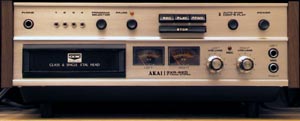
Even more sophisticated than the quadrophonic player, this Akai deck can both record and play 8-track cartridges.
 Leaving aside the question of the effectiveness of quadrophonic
headphones, here's a fine example of 1970s design.
Two little tiny speakers in each of the cereal-bowl-sized headphones,
one in front, one behind.
On the end of a generous length of curly cable are two quarter-inch
jack plugs labelled 'front' and 'rear' (mix them up at your peril).
Leaving aside the question of the effectiveness of quadrophonic
headphones, here's a fine example of 1970s design.
Two little tiny speakers in each of the cereal-bowl-sized headphones,
one in front, one behind.
On the end of a generous length of curly cable are two quarter-inch
jack plugs labelled 'front' and 'rear' (mix them up at your peril).


Just to add to that smell of hot electronics in the living room,
I have two Rogers stereo valve amplifiers.
One is the HG 88 Mark II and the other is the smaller Cadet III model.
Rogers HG88 MkII at Radiomuseum
Rogers Cadet III at Radiomuseum
Return to the Old Sad Things page
Return to John Honniball's home page
Copyright © 1998-2000 by John Honniball. All rights reserved.